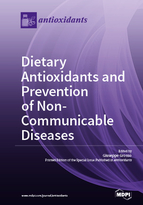Dietary Antioxidants and Prevention of Non-Communicable Diseases
A special issue of Antioxidants (ISSN 2076-3921). This special issue belongs to the section "Health Outcomes of Antioxidants and Oxidative Stress".
Deadline for manuscript submissions: closed (30 April 2018) | Viewed by 141295
Special Issue Editor
Interests: public health nutrition; evidence synthesis; nutritional epidemiology; dietary antioxidants; chronic disease prevention
Special Issues, Collections and Topics in MDPI journals
Special Issue Information
Dear Colleagues,
Numerous epidemiological studies have demonstrated the association between oxidative stress and non-communicable disease, including cardiovascular disorders, mental disease, and several types of cancer. Oxidative stress is commonly known as an imbalance in the production of reactive oxygen species (ROS) and the biological antioxidant defense system. Exogenous antioxidants gained a great attention because of their beneficial role in preventing chronic disease. The balanced diet contain hundreds of naturally occurring antioxidant compounds, including polyphenols and vitamins. Antioxidants are commonly found in vegetables, fruits, cocoa, grain cereals, olive oil, nuts and beverages, such as coffee and tea.
This Special Issue would welcome original research and reviews of literature concerning dietary antioxidants and the following topics:
- observational studies on nutritional cohorts, case-control studies, or population sample on the association with non-communicable disease;
- clinical trials of dietary antioxidants on disease prevention;
- level of evidence on the association with human health, including systematic reviews and meta-analyses;
- in vitro and in vivo studies on molecular mechanisms and targets of dietary antioxidants
Dr. Giuseppe Grosso
Guest Editor
Manuscript Submission Information
Manuscripts should be submitted online at www.mdpi.com by registering and logging in to this website. Once you are registered, click here to go to the submission form. Manuscripts can be submitted until the deadline. All submissions that pass pre-check are peer-reviewed. Accepted papers will be published continuously in the journal (as soon as accepted) and will be listed together on the special issue website. Research articles, review articles as well as short communications are invited. For planned papers, a title and short abstract (about 100 words) can be sent to the Editorial Office for announcement on this website.
Submitted manuscripts should not have been published previously, nor be under consideration for publication elsewhere (except conference proceedings papers). All manuscripts are thoroughly refereed through a single-blind peer-review process. A guide for authors and other relevant information for submission of manuscripts is available on the Instructions for Authors page. Antioxidants is an international peer-reviewed open access monthly journal published by MDPI.
Please visit the Instructions for Authors page before submitting a manuscript. The Article Processing Charge (APC) for publication in this open access journal is 2900 CHF (Swiss Francs). Submitted papers should be well formatted and use good English. Authors may use MDPI's English editing service prior to publication or during author revisions.
Keywords
- antioxidants
- fruits
- vegetables
- functional foods
- nutrition
- non-communicable diseases
- chronic disease
- human health
Related Special Issues
- Oxidative Stress and Inflammation as Targets for Novel Preventive and Therapeutic Approches in Non Communicable Diseases in Antioxidants (15 articles)
- Oxidative Stress and Inflammation as Targets for Novel Preventive and Therapeutic Approaches in Non Communicable Diseases II in Antioxidants (13 articles)







